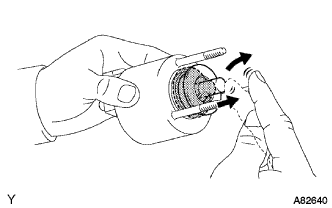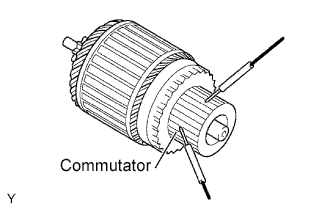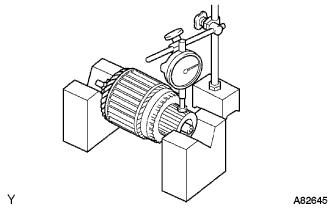Starter -- Inspection |
| 1. INSPECT STARTER ASSEMBLY |
- NOTICE:
- Perform each of the following tests within 3 to 5 seconds.
Perform a pull-in test.
Disconnect the field coil lead wire from terminal C.
Connect the battery to the magnet starter switch as shown in the illustration and check that the pinion gear moves outward.
If the clutch pinion gear does not move, replace the magnet switch assembly.

Perform a hold-in test.
Check that the pinion gear does not return inward after the cable is disconnected from terminal C.
If the clutch pinion gear returns inward, replace the magnet starter switch assembly.

Inspect the clutch pinion gear return.
Disconnect the negative (-) lead from the switch body.
Check that the pinion gear moves inward.
If the clutch pinion gear does not return inward, replace the magnet starter switch assembly.
 |
Perform an operation test without load.
Connect the lead wire to terminal C.
- Torque:
- 10 N*m{102 kgf*cm, 7.4 ft.*lbf}
Clamp the starter in a vise.
Connect the battery and ammeter to the starter as shown in the illustration.
Check that the starter rotates smoothly and steadily with the clutch pinion gear extended.
Check that the ammeter indicates the specified current.- Standard Current:
Tester Connection Condition Specified Condition Battery positive terminal - Terminal 30 - Terminal 50 11.5 V Below 90 A

| 2. INSPECT MAGNET STARTER SWITCH ASSEMBLY |
Check the plunger.
Push in the plunger, then check that it returns quickly to its original position.
If necessary, replace the magnet starter switch assembly.
 |
Inspect the resistance of the pull-in coil.
Using an ohmmeter, measure the resistance between terminals 50 and C.
- Standard Resistance:
Tester Connection Condition Specified Condition Terminal 50 - Terminal C - Below 1 Ω
 |
Inspect the resistance of the hold-in coil.
Using an ohmmeter, measure the resistance between terminal 50 and switch body.
- Standard Resistance:
Tester Connection Condition Specified Condition Terminal 50 - Body ground - Below 2 Ω
 |
| 3. INSPECT STARTER ARMATURE ASSEMBLY |
Inspect the resistance of the commutator.
Using an ohmmeter, measure the resistance between any 2 segments of the commutator.
- Standard Resistance:
Tester Connection Condition Specified Condition Segment - Segment - Below 1 Ω
 |
Check the commutator for a short to ground.
Using an ohmmeter, measure the resistance between the commutator and the armature coil core.
- Standard Resistance:
Tester Connection Condition Specified Condition Commutator - Armature - 10 kΩ or higher
 |
Check the appearance.
If the surface is dirty or burnt, restore the surface with sandpaper (No. 400) or on a lathe.
Check the commutator circuit for runout.
Place the commutator on V-blocks.
Using a dial indicator, measure the circle runout.
- Standard runout:
- 0.02 mm (0.000787 in.)
- Maximum runout:
- 0.05 mm (0.00197 in.)
 |
Using a vernier caliper, measure the commutator diameter.
- Standard diameter:
- 29 mm (1.14 in.)
- Minimum diameter:
- 28 mm (1.10 in.)
 |
Check that the undercut portion is clean and free of foreign matter. Smooth out the edges.
- Standard undercut depth:
- 0.7 mm (0.0276 in.)
- Minimum undercut depth:
- 0.2 mm (0.00787 in.)
 |
| 4. INSPECT STARTER BRUSH HOLDER ASSEMBLY |
Remove the claw of the spring, then remove the 4 brushes.
Using a vernier caliper, measure the brush length.
- Standard length:
- 14.4 mm (0.567 in.)
- Minimum length:
- 9.0 mm (0.354 in.)

Check the brush holder.
Using an ohmmeter, measure the resistance between the brushes.
- Standard Resistance:
Tester Connection Condition Specified Condition A - B - 10 kΩ or higher A - C - 10 kΩ or higher A - D - Below 1 Ω B - C - Below 1 Ω B - D - 10 kΩ or higher C - D - 10 kΩ or higher
 |
| 5. INSPECT STARTER CENTER BEARING CLUTCH SUB-ASSEMBLY |
Inspect the gear teeth on the planetary gear, internal gear and starter clutch for wear or damage.
If damaged, replace the gear or clutch assembly. Also check the planetary gears for wear or damage.
Inspect the starter clutch.
Rotate the clutch pinion gear clockwise and check that it turns freely. Try to rotate the clutch pinion gear counterclockwise and check that it locks.
If necessary, replace the starter center bearing clutch sub-assembly.
 |